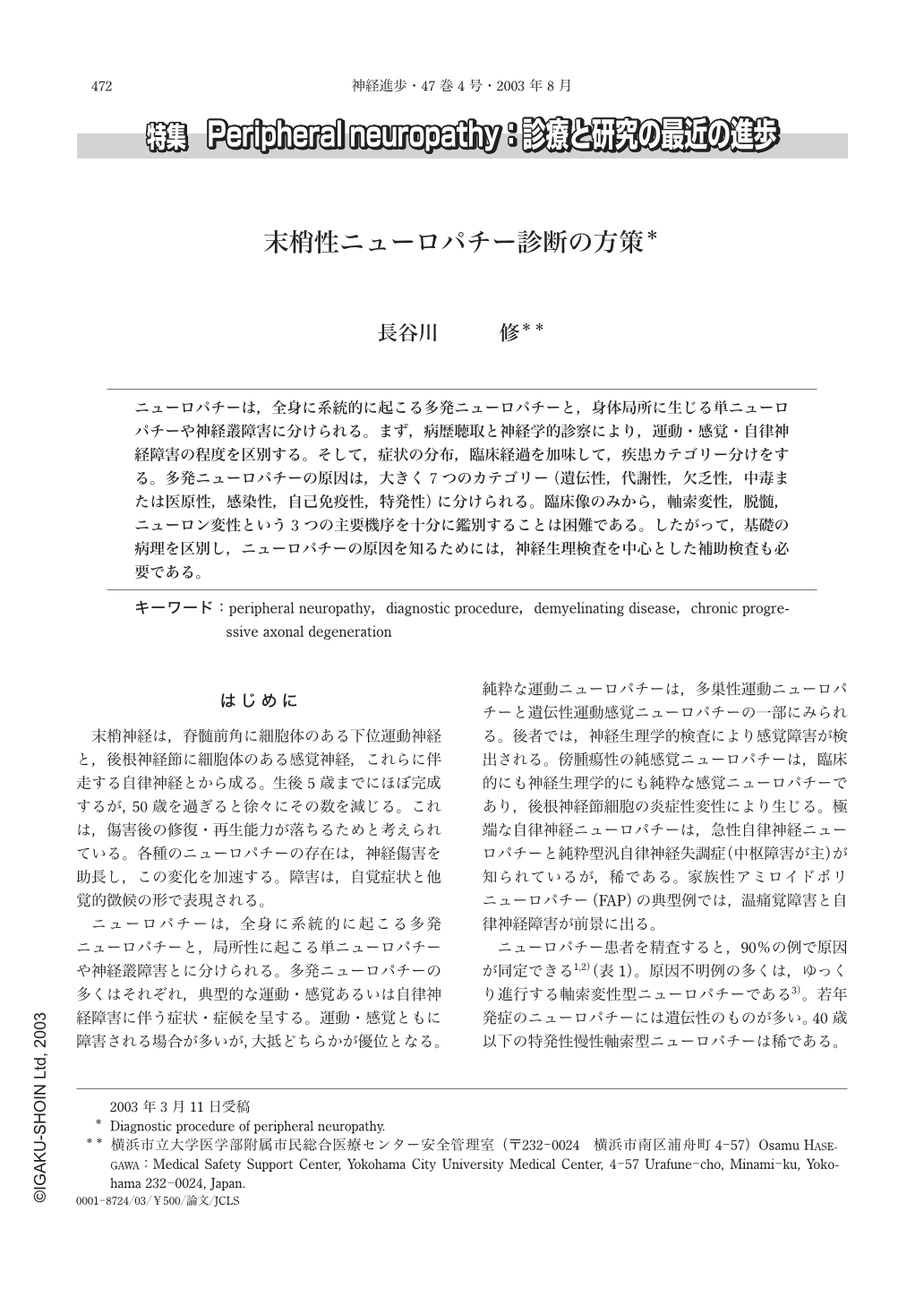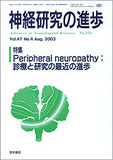Japanese
English
- 有料閲覧
- Abstract 文献概要
- 1ページ目 Look Inside
ニューロパチーは,全身に系統的に起こる多発ニューロパチーと,身体局所に生じる単ニューロパチーや神経叢障害に分けられる。まず,病歴聴取と神経学的診察により,運動・感覚・自律神経障害の程度を区別する。そして,症状の分布,臨床経過を加味して,疾患カテゴリー分けをする。多発ニューロパチーの原因は,大きく7つのカテゴリー(遺伝性,代謝性,欠乏性,中毒または医原性,感染性,自己免疫性,特発性)に分けられる。臨床像のみから,軸索変性,脱髄,ニューロン変性という3つの主要機序を十分に鑑別することは困難である。したがって,基礎の病理を区別し,ニューロパチーの原因を知るためには,神経生理検査を中心とした補助検査も必要である。
はじめに
末梢神経は,脊髄前角に細胞体のある下位運動神経と,後根神経節に細胞体のある感覚神経,これらに伴走する自律神経とから成る。生後5歳までにほぼ完成するが,50歳を過ぎると徐々にその数を減じる。これは,傷害後の修復・再生能力が落ちるためと考えられている。各種のニューロパチーの存在は,神経傷害を助長し,この変化を加速する。障害は,自覚症状と他覚的徴候の形で表現される。
ニューロパチーは,全身に系統的に起こる多発ニューロパチーと,局所性に起こる単ニューロパチーや神経叢障害とに分けられる。多発ニューロパチーの多くはそれぞれ,典型的な運動・感覚あるいは自律神経障害に伴う症状・症候を呈する。運動・感覚ともに障害される場合が多いが,大抵どちらかが優位となる。純粋な運動ニューロパチーは,多巣性運動ニューロパチーと遺伝性運動感覚ニューロパチーの一部にみられる。後者では,神経生理学的検査により感覚障害が検出される。傍腫瘍性の純感覚ニューロパチーは,臨床的にも神経生理学的にも純粋な感覚ニューロパチーであり,後根神経節細胞の炎症性変性により生じる。極端な自律神経ニューロパチーは,急性自律神経ニューロパチーと純粋型汎自律神経失調症(中枢障害が主)が知られているが,稀である。家族性アミロイドポリニューロパチー(FAP)の典型例では,温痛覚障害と自律神経障害が前景に出る。
ニューロパチー患者を精査すると,90%の例で原因が同定できる1,2)(表1)。原因不明例の多くは,ゆっくり進行する軸索変性型ニューロパチーである3)。若年発症のニューロパチーには遺伝性のものが多い。40歳以下の特発性慢性軸索型ニューロパチーは稀である。
Neuropathy,dysfunction of peripheral nerves,is usually quite easily diagnosed, because most neuropathies show characteristic motor, sensory and sometimes autonomic symptoms and signs. Although the majority of polyneuropathies share a mixed sensory-motor pattern of abnormalities, either pattern may predominate or be exclusively present. Examples of pure motor neuropathies are multifocal motor neuropathy and some forms of hereditary motor and sensory neuropathy. In the latter, dysfunction of sensory nerves may only be demonstrated after neurophysiological analysis. Paraneoplastic pure sensory neuropathy is an example of a clinical and neurophysiological pure sensory neuropathy, which is caused by inflammatory degeneration of dorsal root ganglion cells. After a careful work-up of a patient with a neuropathy, in about 90%of cases a cause can be identified. If no cause is found, the neuropathy is usually based upon axonal degeneration and characterized by slow progression. Studies of idiopathic axonal neuropathies have usually excluded the young as it was hypothesized that early-onset neuropathies were more likely to be hereditary. By definition a polyneuropathy is a symmetrical disorder of peripheral nerves with more sensory than motor symptoms and signs, affecting the legs more prominently compared with the arms and distally more than proximally. In neuropathy, weakness is usually caused by dysfunction of motor nerves. On the other hand, severe disturbance of proprioceptive functions may impede movements, as does pain. Skeletal abnormalities, especially scoliosis may be a feature of early onset neuropathy. If the neuropathy is caused by a hereditary disease, a disturbance of the metabolism, a vitamin deficiency, an intoxication, if there is an association with a monoclonal protein or if no cause can be detected, the distribution of clinical symptoms and signs is usually classical. After establishing the clinical pattern, the next step is to determine the time course of the neuropathy. In this respect acute by definition means reaching the zenith within 4 weeks. Examples of acute polyneuropathy are the Guillain-Barrésyndrome and critical illness neuropathy. Subacute neuropathies reach a maximal deficit within 12 weeks. Most neuropathies are chronic progressive with handicap increasing during years. These include neuropathies in all categories. After the clinical diagnosis of polyneuropathy has been made, the specific cause has to be established. Polyneuropathy may have one of hundred different causes. The clinical examination is not apt to differentiate between the three principal mechanisms of axonal degeneration, demyelination and neuronal degeneration. Therefore ancillary tests are needed to discriminate between the basic pathological mechanisms and to find the cause of the polyneuropathy. Clinical neurophysiological testing is the first of these tests. Neurophysiological testing is needed to discriminate between neuronal degeneration, axonal degeneration and demyelination, to search for subclinical evidence of involvement of motor or sensory nerves, next to search for motor nerve conduction block and finally, but eventually to measure the extent of axonal degeneration. CSF analysis is not indicated in axonal polyneuropathies with a classical pattern of abnormalities. Indication of sural nerve biopsy has recently be very limited. There are many types of characteristic focal neuropathies. These are caused by compression, infection or vasculitis and so on. In these focal neuropathies basic mechanism including the cause and the severity should be well understood.

Copyright © 2003, Igaku-Shoin Ltd. All rights reserved.


